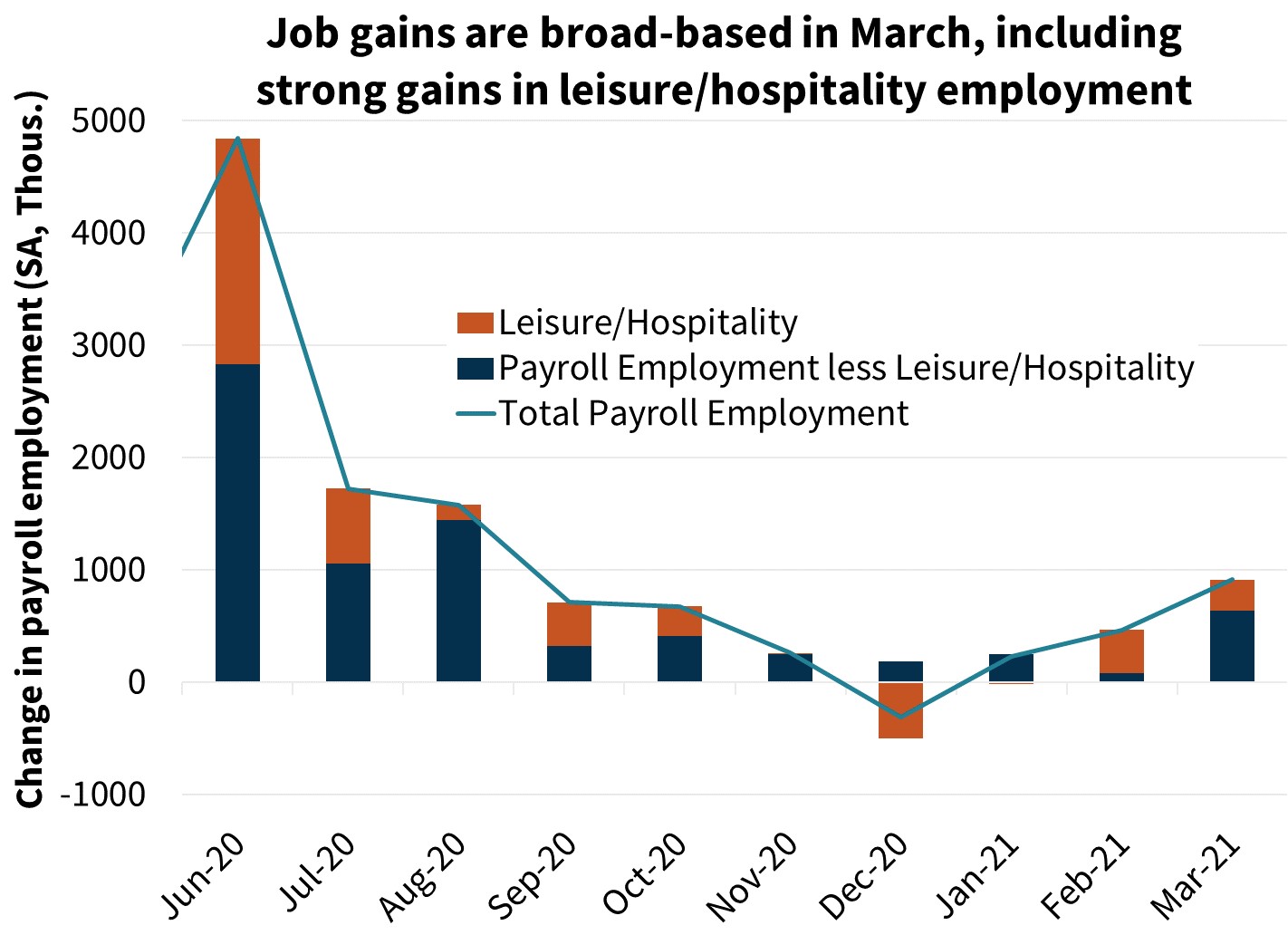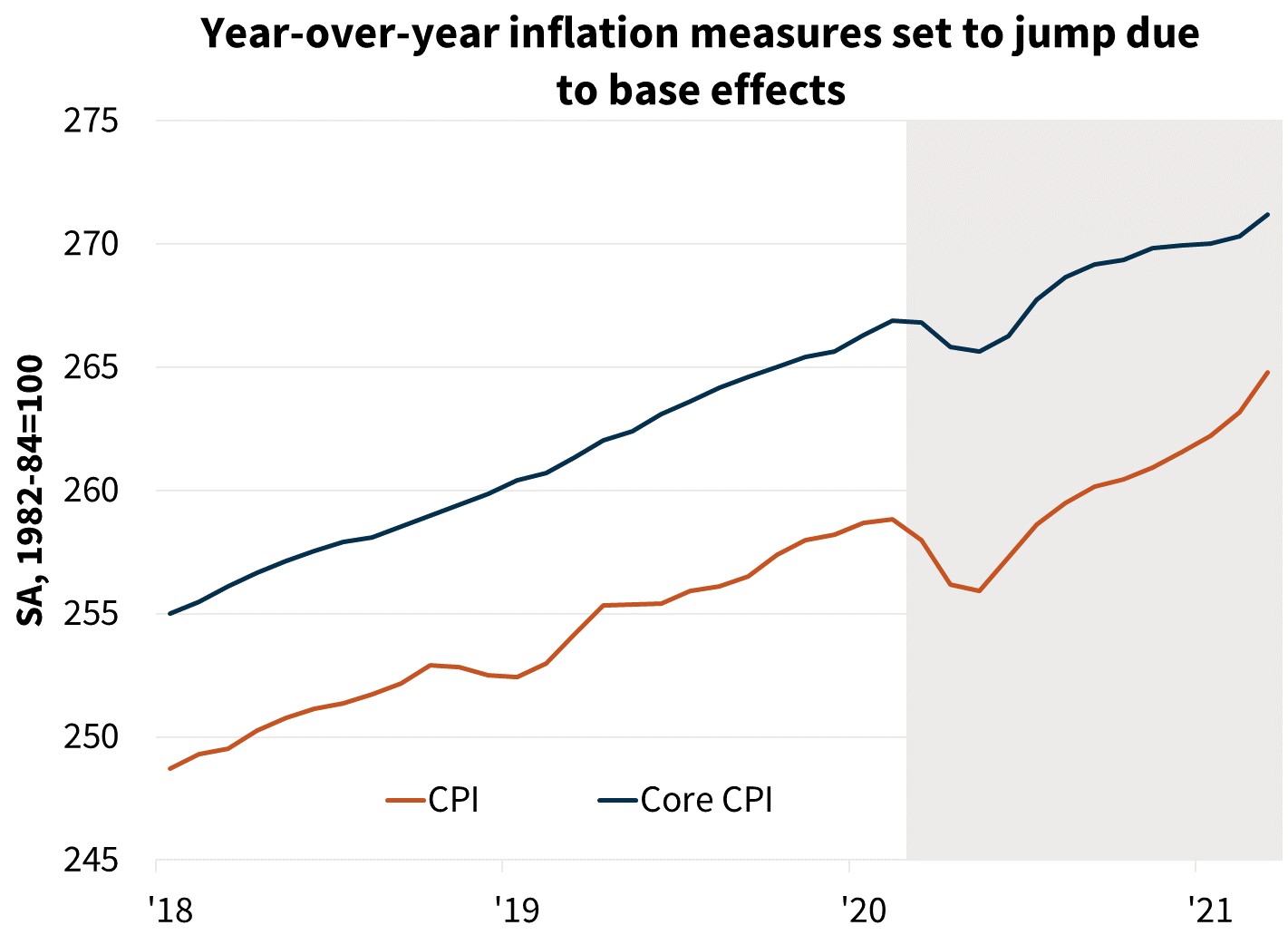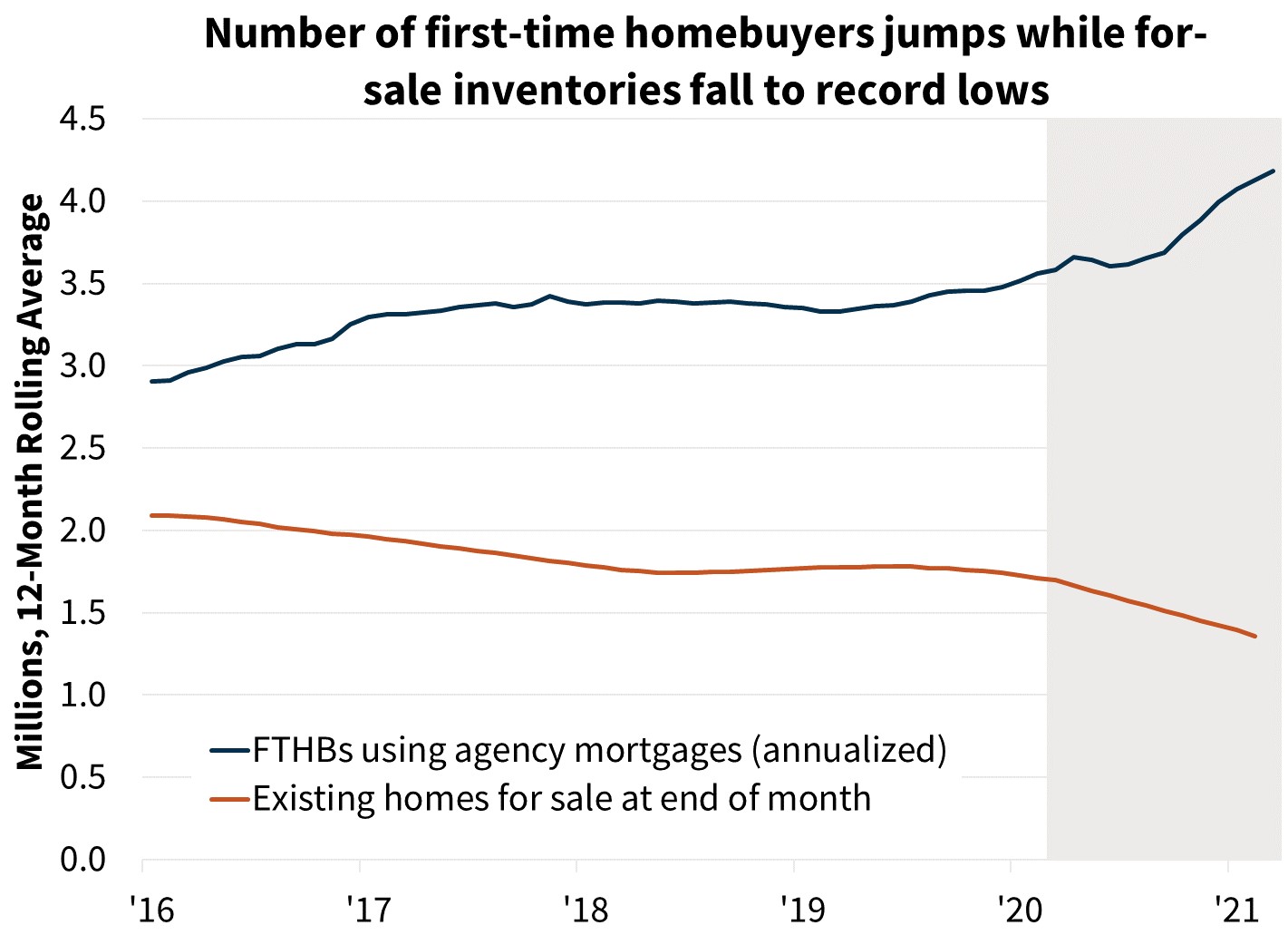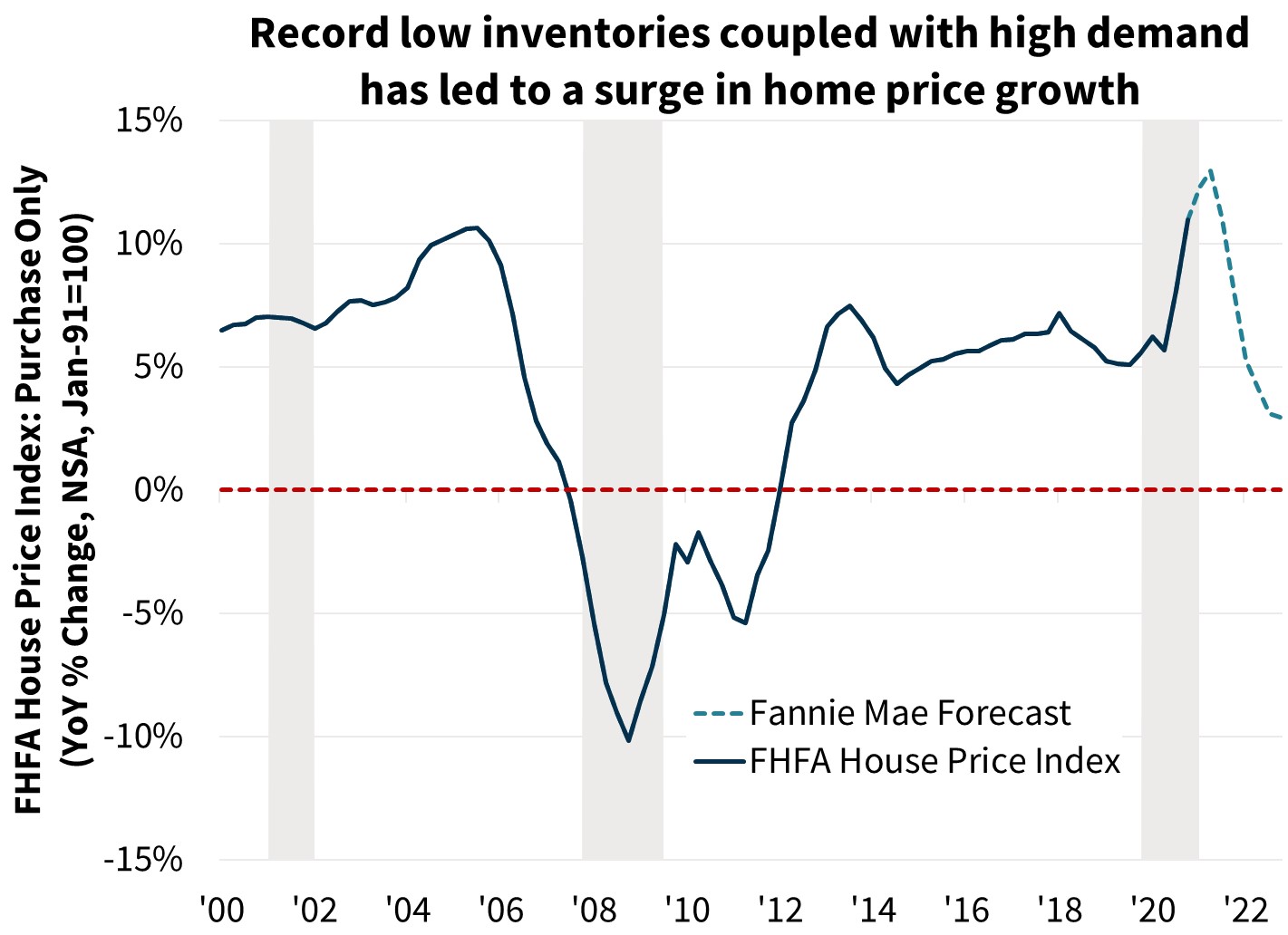Economic Recovery Kicks into High Gear as Housing Market Faces Continued Tight Supply
Economic growth rebounded sharply in March following a weather-related pullback in February. Our 2021 GDP forecast is now 6.8 percent, up from a prior 6.6 percent, on a fourth quarter-over-fourth quarter basis. Our 2022 forecast remains unchanged at 3.0 percent. Growth has been supported by waning COVID-19-related restrictions as the vaccination effort progresses, as well as a bolstering of household incomes from the latest stimulus bill. Uncertainty remains over the speed and duration of the current leg of the recovery, but we continue to anticipate a brisk acceleration in the near term, with growth in the second quarter expected at 9.1 percent annualized.
Home purchase demand remained strong in the first quarter; however, the lack of available listings will likely continue to hold back potential sales. We changed our home sales forecast modestly this month, with a slight downward revision to the sales of existing homes largely offset by an upward revision to the sales of new homes. We continue to expect a slowdown in the monthly pace of both existing and new sales later in the year; however, on an annual basis, total sales are forecast to be 6.2 percent higher than 2020. Consistent with strong demand and limited supply, we upgraded our quarterly home price forecast to 8.0 percent in 2021 (previously 4.2 percent), followed by a deceleration to 2.9 percent in 2022 (previously 2.5 percent), as measured by the FHFA Purchase-Only Index. This higher house price outlook more than offsets our modestly higher interest rate forecast, resulting in an upward revision in our forecast of mortgage originations. We now forecast overall single-family mortgage market originations in 2021 and 2022 to total $4.0 trillion and $3.0 trillion, up from $3.9 trillion and $2.9 trillion, respectively.
As Always, There Are Risks
The pandemic-driven recession of 2020 was unprecedented, and so too is this next stage of economic recovery. While growth is clearly accelerating, consumers’ eagerness to return to previously restricted activities is somewhat uncertain, as is their willingness to tap into the nearly $2 trillion in built-up savings from the past year. There are other meaningful risks to the macro forecast, as well, including ongoing supply chain disruptions, most notably semiconductors (and related auto manufacturing) and shipping bottlenecks. We assume these problems will be resolved in 2021, but if they intensify they will likely hold back the pace of growth. Thus, there is uncertainty over the pace of inflation, conditioned in part on the extent to which the productive capacity of the economy was damaged due to last year’s disruptions. If a combination of surging consumer demand coupled with ongoing supply constraints leads to higher inflation, the Fed may be compelled to tighten monetary policy more quickly than we currently expect. Future developments in fiscal policy, notably a potential infrastructure and tax bill, have not been incorporated into our current baseline forecast. Lastly, COVID variants that resist current vaccines, or further complications regarding the vaccination roll out, cannot be ruled out.
Aside from macroeconomic uncertainty, the housing outlook offers additional risks. We believe the majority of marginal home purchase demand added since last year’s delayed homebuying season waned was driven by households bringing forward their plans to move; thus, we expect some of the home sale surge will begin to wane in 2021. However, if people increasingly reassess their desired housing arrangements post-COVID, then a heightened level of sales could potentially be sustained for a longer period. Additional uncertainty surrounds the timing and implications of the end of the forbearance policies and how those might impact the number and nature of home sales. However, we believe continued improvement in the labor market and higher levels of home equity will likely help limit distressed sales.
Recovery Is Accelerating

Following a slew of weather-driven weak economic data in February, March indicators generally showed a surge in activity. Most evidently, payroll employment gains jumped to 916,000 over the month, up from 468,000 in February and the fastest pace since August 2020. We expect payroll growth in the coming months to average a similar pace. Auto sales, an early indicator for consumer spending, surged 12.6 percent in March to the highest level since 2005, and consumer confidence surveys jumped to their highest levels since the April 2020 downturn. The ISM Manufacturing survey rose by 3.9 points to 64.7, the highest level since 1983, indicating strong manufacturing sector activity as the production side of the economy works to meet strong consumer demand. More recently, high frequency data, such as air travel passengers and restaurant reservations, turned noticeably upward. Activity tended to rebound most swiftly in states where COVID-related restrictions were removed and case counts were declining, suggesting to us the remainder of the country will soon follow.
In our previous forecast, we assumed that the latest round of stimulus checks would begin to be distributed in April. These transfers actually began in mid-March, likely pushing personal consumption growth higher in the first quarter than we previously forecast. Since this injection of funds to households stretched across the end of the first quarter and into the second, there is some uncertainty over which quarter will account for the expected increase in personal consumption. Regardless, our upward revision to personal consumption growth was largely offset by a downward revision to inventory investment. Strong consumer demand coupled with ongoing supply chain disruptions have resulted in firms struggling to build inventories. We expect these issues will eventually be resolved with additions to inventory, adding to growth as the year progresses.
Monthly Inflation Movements will be Key to Uncovering Longer-Term Inflation Trends
The headline rate of inflation will likely continue to jump in the near term as the economy accelerates. Due to the brief deflationary period that occurred in the wake of initial COVID-related shutdowns, year-over-year price level comparisons are expected to accelerate sharply over the next few months. We expect annual growth in the Consumer Price Index (CPI) to meaningfully exceed 3.0 percent in the second quarter, up from 1.7 percent in February and 2.6 percent in March. We expect much of this increase will be transitory, with less extreme year-over-year comparisons beginning in July, leading to smaller annual inflation readings.

Therefore, monthly changes in inflation will take on greater importance as more economic activities reopen. Prices of many commodities and materials rose swiftly over the past year, but this was largely offset by soft or even declining prices in healthcare, rents, and some particularly hard-hit services and retail subsectors. Housing rents and healthcare prices began to turn upward in recent months, and as COVID-related restrictions wane, pricing pressures may build in the sectors that had previously experienced little pricing power. Core CPI, which excludes volatile energy and food prices, rose 0.3 percent in March on a month-over-month basis, supporting recent business surveys that indicate a rising share of firms expect to raise prices in the near future. The Producer Price Index (PPI), which measures the price level of goods and services purchased by firms, has accelerated considerably, rising 4.2 percent year over year in March. At least some of these costs are likely to be passed on to consumers. The payroll quits rate recovered back to pre-COVID levels in February, suggesting many workers feel sufficiently confident to look for other work and are able to do so. Therefore, employers may face upward wage pressures to retain employees sooner than might otherwise be expected. This is in stark contrast to the prior two recessions in which the quits rate remained subdued for multiple years due to heightened labor market slack. This, by itself, does not necessarily indicate strong inflation pressure, but it suggests meaningful disinflation through the labor market (a common occurrence after recessions) is not present in the current period. While we believe the near-term jump in annual inflation measures is likely to pass, we do expect a modestly accelerating underlying trend to continue throughout this year and into 2022.
The minutes from the Federal Open Market Committee’s (FOMC) March 16-17 meeting were largely unsurprising. Members reiterated their commitment to an accommodative policy and to allowing inflation to run hot until their employment and inflation outcomes are achieved. However, if month-over-month comparisons in inflation measures are stronger than expected, speculation that the Fed will have to tighten policy soon will likely lead to a further rise in interest rates. There is already a growing disconnect between the Fed Funds futures market, which anticipates rate hikes to begin in late 2022 or early 2023, and the Fed’s official forecast, which expects hikes to begin in 2024. The next few months will likely be pivotal in determining which way this disconnect converges.
Lack of Listings Hinders Home Sales and Bolsters Prices
While the magnitudes were somewhat greater than we anticipated, most housing-related metrics pulled back sharply in February as expected due to harsh weather and the related power outages. New home sales fell 18.2 percent over the month, while pending sales declined by 10.6 percent. Existing home sales, which lag contract signings by about 30 to 45 days, on average, will therefore likely be considerably weaker in March and perhaps April. However, we believe a strong rebound is likely to follow.

Even as mortgage rates drift upward, home purchase demand remains robust. Purchase mortgage applications rebounded after the February pull back, while the Fannie Mae Home Purchase Sentiment Index (HPSI) rose 5.2 points in March. Our analysis of MBS issuance data showed that about 550,000 additional homes were purchased in 2020 by first-time homebuyers using an agency-backed mortgage compared to the pace of recent years. Our recent report on homebuyer migration patterns using data from Fannie Mae’s Desktop Underwriter revealed that these additional home purchases were disproportionately driven by renters moving out of dense urban areas, a phenomenon that has continued into early 2021. Our previous household survey work suggested that much of this demand was pulled forward in time, reflecting renters who were already planning to purchase a home in the upcoming years deciding to do so earlier than expected in light of COVID-related restrictions, work-from-home options, and lower mortgage rates. However, these same survey results failed to find largescale changes in households’ attitudes toward where they would like to live. We therefore assume that this heightened demand will wane considerably as more COVID-related restrictions are lifted and the economic recovery continues. For the time being, however, home purchase demand continues to be strong.
We continue to view the lack of homes for sale as the primary constraint on home purchases in the near term. With just over 1 million existing homes listed for sale at the end of February, inventories at the start of this year’s spring homebuying season were down 29.5 percent from the year prior to a record low. As discussed in our March commentary, we expect that a modest future rise in mortgage rates would not materially hinder sales in the short run, as there is an ample pool of would-be buyers currently being outbid or unable to find a listing who would be ready to take the place of buyers who are priced out due to rising mortgage rates.
Consistent with strong home purchase demand and a highly restricted supply of homes for sale, swift home price appreciation continues. As measured by the FHFA Purchase-Only Index, prices were up 12.0 percent from a year prior as of January. We significantly upgraded our quarterly home price forecast for the same measure and now project home prices to rise 8.0 percent in 2021. We then expect home price appreciation to decelerate to 2.9 percent in 2022 as demand wanes and mortgage rates continue to drift upward, creating affordability pressure.

Strong home price appreciation will continue to support new construction. We upgraded our near-term forecast for single-family housing starts, and we now project the 2021 total to be 1.23 million, up 23.8 percent from 2020 and the highest level since 2006. Housing starts pulled back in February due to cold weather; however, the pace of construction permits remained considerably above the pace of starts for the second straight month. This is supportive of a jump in construction beginning in March. Homebuilders remained highly confident in the first quarter as they struggled to keep up with demand and reported continued brisk buyer foot traffic. If not for the supply constraints that builders are also facing, such as the high price of lumber and other construction materials, we would expect the pace of starts to be even stronger.
Multifamily starts also pulled back in February, but here, too, we expect a rebound. We made only slight changes to our multifamily construction forecast and project starts in 2021 to be 392,000, a level similar to 2020. While this represents a solid pace, the softness relative to single-family construction reflects weakness in some large urban centers. However, we believe a recent upturn in rent metrics and supportive vacancy rates may further drive developer interest in less expensive metro areas and suburban locations.
For more on multifamily market conditions please see the April 2021 Multifamily Market Commentary.
Mortgage Originations Upgraded on Higher Home Price Forecast
Consistent with a stronger home price growth forecast, we upgraded our outlook for single-family purchase mortgage originations. We now expect 2021 and 2022 purchase volumes for the overall mortgage market to total $1.9 trillion for each year, an upward revision of $66 billion and $84 billion, respectively, from last month’s forecast.
We expect refinance origination volume for the single-family mortgage market to be $2.1 trillion in 2021, unchanged from last month’s forecast, as the positive impact from a stronger home price forecast and the negative impact from a higher interest rate forecast essentially offset each other. Refinance volumes will likely slow as mortgage rates are expected to rise modestly over the next two years. We expect refinance origination volumes in 2022 to total $1.1 trillion, a 48 percent decline from 2021 and a $40 billion downward revision from last month’s forecast. We estimate that around 42 percent of all outstanding mortgages have at least a 50-basis point incentive to refinance at current rates, which is down from nearly 70 percent at the end of 2020.
The impressive run-up in interest rates over the first quarter appears to have settled down in recent weeks. After peaking at the end of March near 1.75 percent, the 10-year Treasury rate moderated in early April and now sits at 1.62 percent as of this writing. However, the 10-year Treasury remains low compared to recent historical levels; the 10-year Treasury rate averaged 2.32 percent between 2011 and 2019. We expect rates to gradually increase further over the course of the year.
In March, the 30-year fixed mortgage rate averaged 3.08 percent according to Freddie Mac, up 27 basis points from February’s average, and is 3.13 percent as of this writing. Mortgage spreads compressed further over the month with the primary/secondary spread (30-year mortgage contract rate minus the 30-year current coupon yield) narrowing for the seventh consecutive month to 113 basis points, the smallest gap since February 2020. Spreads have compressed significantly over the past year, and while lenders may be willing to absorb these costs to maintain high volumes for a little while longer, we believe lenders are likely to increasingly pass a greater share of higher funding costs onto borrowers if the 10-year Treasury rate continues to move upward.
Economic & Strategic Research (ESR) Group
April 13, 2021
For a snapshot of macroeconomic and housing data between the monthly forecasts, please read Economic and Housing Weekly Notes.
Data sources for charts: Bureau of Labor Statistics, Fannie Mae, Federal Housing Finance Agency, Fannie Mae ESR Group.
Opinions, analyses, estimates, forecasts and other views of Fannie Mae's Economic & Strategic Research (ESR) Group included in these materials should not be construed as indicating Fannie Mae's business prospects or expected results, are based on a number of assumptions, and are subject to change without notice. How this information affects Fannie Mae will depend on many factors. Although the ESR group bases its opinions, analyses, estimates, forecasts and other views on information it considers reliable, it does not guarantee that the information provided in these materials is accurate, current or suitable for any particular purpose. Changes in the assumptions or the information underlying these views could produce materially different results. The analyses, opinions, estimates, forecasts and other views published by the ESR group represent the views of that group as of the date indicated and do not necessarily represent the views of Fannie Mae or its management.
ESR Macroeconomic Forecast Team
- Doug Duncan, SVP and Chief Economist
- Mark Palim, VP and Deputy Chief Economist
- Eric Brescia, Economist
- Nick Embrey, Economist
- Rebecca Meeker, Financial Economist
- Richard Goyette, Business Analyst
